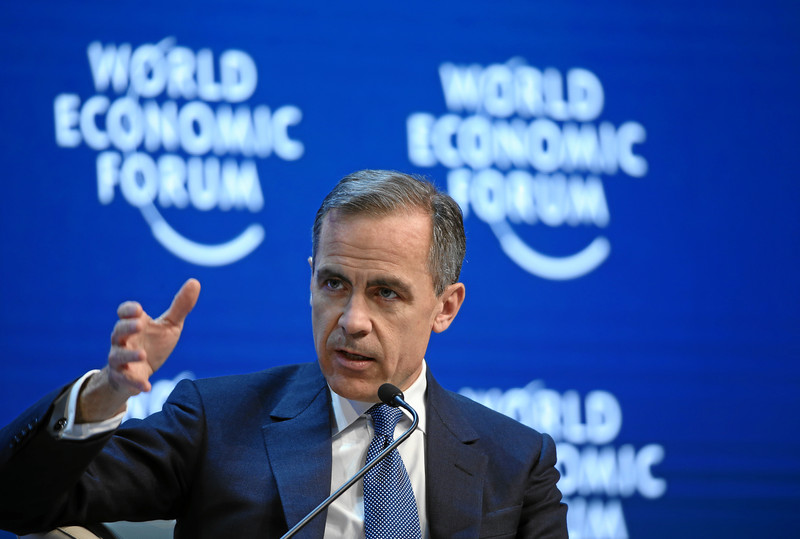Business
Declining Canadian dollar could stifle productivity growth in Canada

From the Fraser Institute
By Steven Globerman and Lawrence Schembri
The Bank of Canada’s decision last week to lower its policy rate by 50 basis points increases the gap between the U.S. Federal Reserve’s policy rate and the Bank of Canada’s rate to approximately 130 basis points. While this gap might close somewhat if the Federal Reserve lowers its rate at its meeting this week, a substantial U.S. premium will still exist.
Since borrowing rates are tied to policy rates, interest rates in Canada will remain well below those in the U.S. for the foreseeable future. This gap will continue to put downward pressure on the value of the Canadian dollar against the U.S. greenback, as investors favour higher-earning U.S. dollar-denominated assets over Canadian dollar assets. President-elect Trump’s threatened trade actions against Canada could also exert further downward pressure on the loonie, especially if the Bank of Canada responds to Trump’s actions by making additional rate cuts. For context, it took $1.33 Canadian dollars to purchase one U.S. dollar on January 1, 2024, compared to $1.43 Canadian dollars on December 13, 2024. This represents a substantial depreciation in the Canadian dollar’s value of approximately 7.6 per cent over the period.
What effects will a declining Canadian dollar have on the Canadian economy?
In short, it will increase demand for domestic output and labour and put upward pressure on inflation via higher import prices, and it could also lower productivity growth and further hurt living standards.
Why the impact on productivity?
Because Canada imports most of its machinery and equipment (including information and communications technology) from the U.S. and other countries, and investment in this type of physical capital helps drive productivity growth. A declining Canadian dollar makes capital equipment imports more expensive, thereby discouraging investment and slowing productivity growth. A declining Canadian dollar may also shelter domestic firms from foreign competition, which could dampen their incentive to invest in productivity-enhancing assets, even if they price their output in U.S. dollars.
Hence, if the Canadian dollar remains weak against the U.S. dollar and other currencies, it may be more difficult to reverse Canada’s productivity woes. Again, productivity—the amount of GDP per hour of labour the economy produces—is key to improving living standards, which have been on the decline in Canada. From July to September of 2024, the economy grew by 0.3 per cent yet per-person GDP (an indicator of living standards) fell by 0.4 per cent (after adjusting for inflation).
Canada also indirectly imports technology via direct investments made by U.S.-based companies in their Canadian subsidiaries. While a declining Canadian dollar makes it cheaper for U.S. companies to buy assets in Canada, it also reduces the U.S. dollar value of profits earned over time in Canada by American-owned companies. This phenomenon, combined with an unstable Canadian dollar, might discourage inward foreign direct investment and associated technology transfers by increasing the financial uncertainty of such investment.
To be clear, this is not a criticism of the Bank of Canada’s move last week to help lower domestic interest rates given the Bank’s primary mandate to meet its inflation rate target of 2 per cent. Rather, governments—including the Trudeau government—must enact policies to encourage business investment in productivity-enhancing assets.
For starters, policymakers should reduce business tax rates and the tax rate on capital gains, to encourage innovation and entrepreneurship. They should also dramatically reduce the regulatory burden and other barriers to entry and growth, especially those faced by small and medium-sized businesses. And the federal and provincial governments should increase competition in the domestic economy by reducing interprovincial trade barriers.
For example, the provinces could adopt a policy of “mutual recognition” so the standards and licencing requirements in one province would be accepted by all provinces. Provinces can also unilaterally eliminate self-imposed trade barriers (as Alberta did in 2019 with grazing permits for livestock). Of course, due to resistance from special interest groups that benefit from internal barriers, such reforms will not be easy. But the economic risks to the Canadian economy—from even the threat of a trade war with the U.S.—could generate support among Canadians for these reforms. Indeed, reducing interprovincial barriers to trade and labour mobility might be the single most important thing that governments in Canada could do to improve productivity.
With Canada’s lower inflation rate, weaker labour market and weaker economic growth outlook compared to the U.S., lower interest rates in Canada seem appropriate. Bank of Canada Governor Tiff Macklem wants to see economic activity pick up to absorb slack in the economy and prevent inflation settling below the bank’s 2 per cent target. Clearly, the Bank should focus on inflation and domestic economic conditions. But policymakers must do their part to create a better environment for investment and innovation, the keys to productivity and increased living standards for Canadians.
Business
Carney and other world leaders should recognize world’s dependence on fossil fuels

From the Fraser Institute
By Julio Mejía and Elmira Aliakbari
Simply put, despite trillions invested in the energy transition, the world is more dependent on fossil fuels today than when the United Nations launched its first COP. No wonder that ahead of COP30, leading voices of the net-zero-by-2050 agenda, including Bill Gates, are acknowledging both the vital role of fossil fuels on the planet and the failure of efforts to cut them.
On the heels of his first federal budget, which promises more spending to promote a “green economy,” Prime Minister Carney will soon fly to Brazil for COP30, the 30th United Nations climate summit. Like the former Trudeau government, the Carney government has pledged to achieve “net-zero” emissions in Canada—and compel other countries to pursue net-zero—by 2050. To achieve a net-zero world, it’s necessary to phase out fossil fuels—oil, natural gas, coal—or offset their CO2 emissions with technologies such as “carbon capture” or large-scale tree planting.
But after trillions of dollars spent in pursuit of that goal, it appears more unrealistic than ever. It’s time for world leaders, including Canada’s policymakers, to face reality and be honest about the costly commitments they make on behalf of their citizens.
For starters, carbon capture—the process of trapping and storing carbon dioxide so it’s unable to affect the atmosphere—is a developing technology not yet capable of large-scale deployment. And planting enough trees to offset global emissions would require vast amounts of land, take decades to absorb significant CO2 and risk unpredictable losses from wildfires and drought. Due to these constraints, in their net-zero quest governments and private investors have poured significant resources into “clean energy” such as wind and solar to replace fossil fuels.
According to the International Energy Agency (IEA), from 2015 to 2024, the world’s public and private investment in clean energy totalled and estimated US$14.6 trillion (inflation-adjusted). Yet from 1995 (the first COP year) to 2024, global fossil fuel consumption increased by more than 64 per cent. Specifically, oil consumption grew by 39 per cent, natural gas by 96 per cent and coal by 76 per cent. As of 2024, fossil fuels accounted for 80.6 per cent of global energy consumption, slightly lower than the 85.6 per cent in 1995.
The Canadian case shows an even greater mismatch between Ottawa’s COP commitments and its actual results. Despite billions spent by the federal government on the low-carbon economy (electric vehicle subsidies, tax credits to corporations, etc.), fossil fuel consumption in our country has increased by 23 per cent between 1995 and 2024. Over the same period, the share of fossil fuels in Canada’s total energy consumption climbed from 62.0 to 66.3 per cent.
Simply put, despite trillions invested in the energy transition, the world is more dependent on fossil fuels today than when the United Nations launched its first COP. No wonder that ahead of COP30, leading voices of the net-zero-by-2050 agenda, including Bill Gates, are acknowledging both the vital role of fossil fuels on the planet and the failure of efforts to cut them.
Why has this massive effort, which includes many countries and trillions of dollars, failed to transition humanity away from fossil fuels?
As renowned scholar Vaclav Smil explains, it can take centuries—not decades—for an energy source to become globally predominant. For thousands of years, humanity relied on wood, charcoal, dried dung and other traditional biomass fuels for heating and cooking, with coal only becoming a major energy source around 1900. It took oil 150 years after its introduction into energy markets to account for one-quarter of global fossil fuel consumption, a milestone reached only in the 1950s. And for natural gas, it took about 130 years after its commercial development to reach 25 per cent of global fossil fuel consumption at the end of the 20th century.
Yet, coal, oil and natural gas didn’t completely replace traditional biomass to meet the surging energy demand as the modern world developed. As of 2020, nearly three billion people in developing countries still relied on charcoal, straw and dried dung to supply their basic energy needs. In light of these facts, the most vocal proponents of the global energy transition seem, at the very least, out of touch.
The world’s continued reliance on fossil fuels should prompt world leaders at COP30 to exercise caution before pushing the same unrealistic commitments of the past. And Prime Minister Carney, in particular, should be careful not to keep leading Canadians into costly ventures that lead nowhere near their intended results.
Business
Liberals refuse to disclose the amount of taxpayer dollars headed to LGBT projects in foreign countries

From LifeSiteNews
The Liberal government of Prime Minister Mark Carney will not openly disclose how much money from its foreign-aid budget is going toward overseas “gender identity” and “decolonization” projects.
According to the government, there are “concerns” that disclosing the amount of funds could endanger certain LGBT organizations that get money from it.
On November 3, Global Affairs Canada, in response to a question on the order paper from a Conservative MP, said that the funding amounts could not be made public due to claimed “security concerns” and “confidentiality requirements.”
“These are the most common reasons projects are considered sensitive: the organization or individuals might be in danger if it becomes known that they are receiving funds from a foreign government; (or) implementing a project related to sensitive topics such as two-spirit, lesbian, gay, bisexual, transgender, queer, intersex and additional sexually and gender-diverse people rights, human trafficking, early/forced marriage, (and) human rights defenders,” Global Affairs noted.
Continuing, Global Affairs said that there is a possible “danger” to partner organizations that could be “forced to close” or even “arrested” due to “harassment from the local population or government.”
As reported by LifeSiteNews, Carney’s budget will include millions in taxpayer money for “SLGBTQI+ communities,” gender equality, and “pride” safety.
Canada’s 2025 federal budget is allotting some $54.6 million to LGBT groups in a move criticized by Campaign Life Coalition as prioritizing activist agendas over struggling families’ basic needs.
Canadian taxpayers are already dealing with high inflation and high taxes due in part to the Liberal government overspending and excessive money printing, and even admitting that giving money to Ukraine comes at the “taxpayers’” expense.
As recently reported by LifeSiteNews, Bank of Canada Governor Tiff Macklem gave a grim assessment of the state of the economy, essentially telling Canadians that they should accept a “lower” standard of living.
-

 armed forces2 days ago
armed forces2 days agoIt’s time for Canada to remember, the heroes of Kapyong
-

 Business2 days ago
Business2 days agoCarney’s Floor-Crossing Campaign. A Media-Staged Bid for Majority Rule That Erodes Democracy While Beijing Hovers
-

 Business1 day ago
Business1 day agoLiberals refuse to disclose the amount of taxpayer dollars headed to LGBT projects in foreign countries
-

 Daily Caller17 hours ago
Daily Caller17 hours agoUS Nuclear Bomber Fleet Shares Fence With Trailer Park Linked To Chinese Intel-Tied Fraudster
-

 Digital ID1 day ago
Digital ID1 day agoCanada moves forward with digital identification for federal benefits seekers
-

 Alberta1 day ago
Alberta1 day agoSchool defunding petition in Alberta is a warning to parents
-

 espionage17 hours ago
espionage17 hours agoChinese-Owned Trailer Park Beside U.S. Stealth Bomber Base Linked to Alleged Vancouver Repression Case
-

 Daily Caller16 hours ago
Daily Caller16 hours agoLaura Ingraham Presses Trump On Allowing Flood Of Chinese Students Into US












